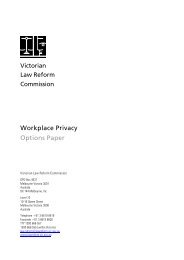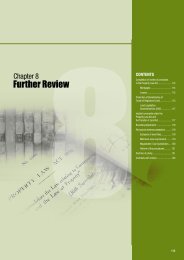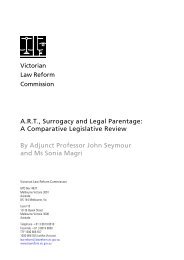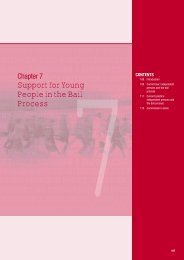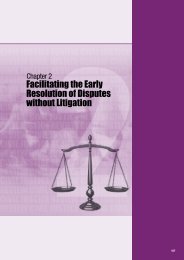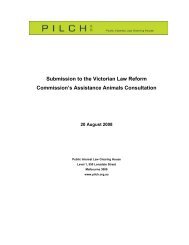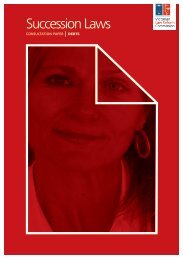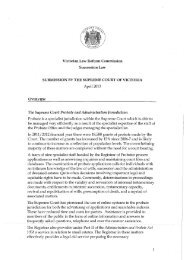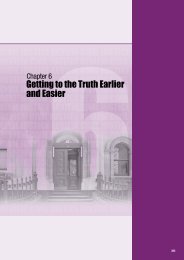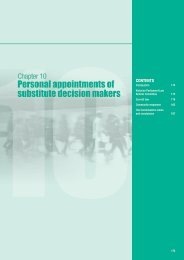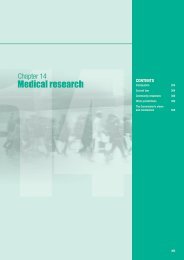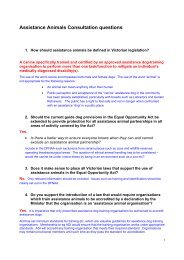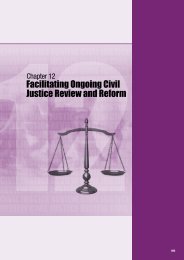Crimes Mental Impairment consultation paper.pdf - Victorian Law ...
Crimes Mental Impairment consultation paper.pdf - Victorian Law ...
Crimes Mental Impairment consultation paper.pdf - Victorian Law ...
Create successful ePaper yourself
Turn your PDF publications into a flip-book with our unique Google optimized e-Paper software.
4<br />
4.5 As stated in [4.11] below, under section 7(1) of the CMIA an accused person is presumed<br />
to be fit to stand trial. Thus, strictly speaking, the issue if it arises is not an issue of<br />
fitness to stand trial but is an issue of unfitness to stand trial. Doubtless for that reason<br />
Part 2 of the CMIA is headed ‘Unfitness to stand trial’, and the pivotal section of Part 2,<br />
section 6, lays down the statutory test of unfitness to stand trial. Despite this, Part 2 goes<br />
on repeatedly to refer to ‘the question of a person’s fitness to stand trial’. In order to be<br />
conceptually correct, this <strong>paper</strong> will refer to ‘unfitness to stand trial’ unless the context<br />
requires otherwise (for example, in referring to the law prior to the CMIA and quoting a<br />
section of the CMIA which uses the expression ‘the question of a person’s fitness to stand<br />
trial’ or decisions of courts which use that expression).<br />
Unfitness to stand trial prior to the CMIA: ‘fitness to plead’<br />
4.6 From at least as early as the fourteenth century, the question of whether an accused<br />
person was fit to plead was a concern for courts. 5 Medieval court procedure required an<br />
accused person to enter a plea of guilty or not guilty to an offence. The inability or refusal<br />
to do so would prevent the trial from proceeding.<br />
4.7 To circumvent this procedural hurdle, an alternative procedure was devised that required<br />
a jury to decide between whether the failure to plead was due to a genuine inability to<br />
enter a plea (‘mute by visitation of God’) or out of choice (‘mute by malice’). Those who<br />
were found by the jury to be ‘mute by visitation of God’ would have a plea of not guilty<br />
entered on their behalf, based on the assumption that it would have been the plea they<br />
would have entered had they been able. Those who were found by the jury to be ‘mute<br />
by malice’, on the other hand, would be subject to the practice of peine forte et dure<br />
(‘strong and hard suffering’). These people were starved and gradually crushed under<br />
increasing weights, in an attempt to force them to plead, or until they died.<br />
4.8 The law in relation to those who were ‘mute by visitation of God’ that forms the basis<br />
of the modern law on unfitness to stand trial remained unclear until the decisions of<br />
R v Dyson 6 and R v Pritchard 7 in the 1830s. These cases are discussed in more detail<br />
at [4.21]–[4.23].<br />
4.9 In Victoria, the law on fitness to plead was adopted through the introduction of<br />
section 393(1) of the <strong>Crimes</strong> Act 1958 (Vic) that provided for the ‘strict custody until the<br />
Governor’s pleasure shall be known’ of accused people tried for indictable offences in the<br />
Supreme Court or County Court and who were found unfit to plead. Section 393(1) was<br />
based on the wording of section 2 of the Criminal Lunatics Act 1800, the first statutory<br />
provision introduced in Great Britain concerning the process in relation to accused people<br />
who may be unfit to plead. Section 393(2) of the <strong>Crimes</strong> Act also provided the court<br />
with the option of making any order it thinks fit to enable the accused person to receive<br />
appropriate services under mental health legislation, after having regard to any evidence<br />
before it relating to the person’s mental health or intellectual disability.<br />
4.10 The process in relation to unfitness to stand trial was not set out in detail in legislation<br />
until the abolition of the Governor’s pleasure system and the introduction of the CMIA.<br />
The CMIA expanded the expression ‘unfitness to plead’ to ‘unfitness to stand trial’ to<br />
reflect that an accused person must be fit at any stage of the proceedings. The CMIA did<br />
not alter the common law test for unfitness to plead, but made a number of important<br />
changes to the process. It gave accused people, who may be unfit to stand trial, the<br />
opportunity of becoming fit (during a 12-month adjournment). It also introduced a<br />
procedure to have the evidence against them tested (with a special hearing process).<br />
Under the Governor’s pleasure system, people were neither given the opportunity to<br />
become fit nor to have the evidence against them tested.<br />
5 Warren J Brookbanks, ‘Fitness to Plead and the Intellectually Disabled Offender’ (1994) 1(2) Psychiatry, Psychology and <strong>Law</strong> 171, 172.<br />
6 (1831) 1 Lewin 62; 168 Eng Rep 960.<br />
7 (1836) 7 C&P 303; 173 ER 135.<br />
53



